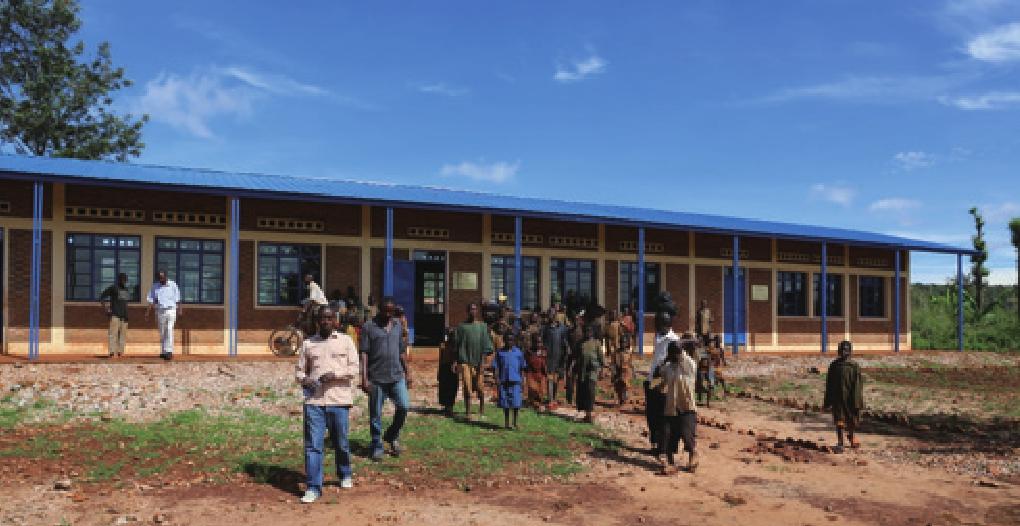Lessons for Life
2019-11-27ByGeLijun
By Ge Lijun

In the library of the Kibii Primary School, around 40 km east of Kenyas capital Nairobi, the children are all smiles—and with good reason. They have just got their hands on a batch of brand new books, a perfect addition to the schools new building, which opened fi ve years ago.
The books and the school building have something in common. They were donated as part of a Chinese assistance project.
The China-Africa Project Hope is a joint initiative of ToJoy, a Chinese company that provides financing and operational support to help enterprises access different markets, and China Youth Development Foundation(CYDF), a non-governmental organization(NGO) in China, launched in 2011. The international assistance project is helping some of Africas poorest rural areas improve their educational environment by building schools, providing educational materials and sending volunteers to work on the ground.
“The partnership between China and Africa is based on the wish to improve peoples livelihoods, and education is the most sustainable way to reduce poverty,” said Xu Zhibing, an executive at the CYDF.
Meeting a crying need
From early 2011, the foundation conducted field visits in Tanzania, Kenya, Burundi, Rwanda and some other African countries. Its offi cials contacted schools, local authorities and companies in the selected countries, as well as the Chinese embassies there.
Finally in 2011, the groundbreaking ceremony for the fi rst Hope Primary School in Tanzania was held.
By August 2015, Project Hope had received more than 40 million yuan ($5.6 million) in donations from Chinese companies. The funding enabled it to build 23 primary schools in Tanzania, Kenya, Burundi, Rwanda and Namibia. The project has also provided the schools with solar-powered lighting, power supply and rainwater harvesting systems.
In March 2017, the project expanded its activities to include donation of textbooks and other learning materials. In Kenyan schools, on average, the current ratio is one textbook for three students, according to the local government.
“Such shortage is due to a lack of resources and the high cost of textbooks, making it difficult to replace old and wornout books,” Habat Sheikh Abdi, Director of Basic Education at Kenyas Ministry of Education, Science and Technology, told China Daily Africa.
Abdi thinks Project Hope will make a signifi cant contribution to improving educational infrastructure and raising the literacy level in Kenya, especially in low-income neighborhoods.
So far, the CYDF has established 10 schools in Kenya, donating 5,340 books and some bookshelves to each.
The Kibii Primary School has about 400 students, most of whom live in slums near the school. “Their parents are very happy to see their children studying here,” the school principal Michael Ngugi said.
An oasis in the slums
Mathare is one of the largest clusters of slums in Nairobi, with nearly 700,000 people living in an area of only 3 square km. Located in the very heart of Mathare is the Chang Rong Light Center. Once a dilapidated school with a shortage of teachers, it was rebuilt in 2014 by a group of young Chinese volunteers and underwent a transformation. Today, it is an oasis for disadvantaged children seeking better education and emotional comfort.
Yin Binbin, who initiated the project, said he was upset by the difficult conditions he witnessed during his fi rst visit to the school. He launched an online donation campaign and with other Chinese volunteers, hired local workers and rebuilt the school in just over 30 days.

“Since it was rebuilt, enrollment has increased greatly. We have recruited qualifi ed teachers who are impressed by our modern facilities,” David Matinde, principal of the school, told Xinhua News Agency.
Matinde used to work in an elite school where he enjoyed a high salary. Eleven years ago, he resigned and came to work in the school in Mathare. At that time, it had only one class of 50 students and two teachers.
During the fi rst two years, he received a meager salary. He sold his house in Nairobi and moved his family to a neighborhood near the slum. Despite all these difficulties, Matinde refused to give up. “I am certain that education will change the fate of these children,” the 41-year-old said.
The changes today are striking. The school has seven classrooms with more than 300 students and seven teachers.
“Chinese NGOs are carrying out social aid projects in Africa to help local populations solve their problems. This has helped strengthen friendship between the two peoples, promote cultural exchanges and develop bilateral relations,” former Chinese Ambassador to Namibia Xin Shunkang said at the inauguration of a Hope Primary School in east Namibia in 2015.
This nearly 1,500-square-meter school with 13 classrooms, an offi ce, a multipurpose hall and a sports fi eld was built by a Chinese company. It can accommodate nearly 600 students.
Before it was built, the local children had to walk more than 10 km to go to the nearest school.
